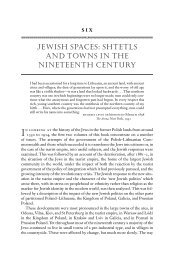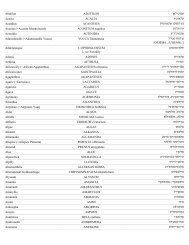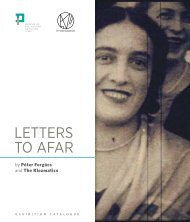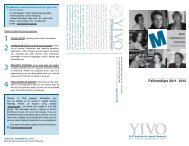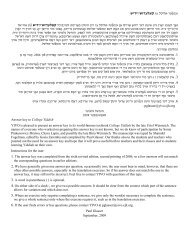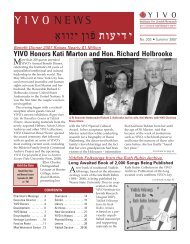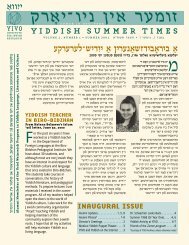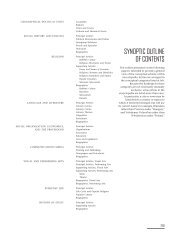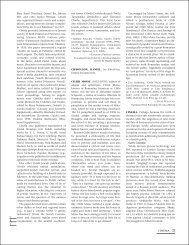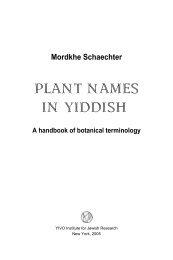geographical–political units - YIVO Institute for Jewish Research
geographical–political units - YIVO Institute for Jewish Research
geographical–political units - YIVO Institute for Jewish Research
Create successful ePaper yourself
Turn your PDF publications into a flip-book with our unique Google optimized e-Paper software.
literature after a scandal caused by his biting satire on the powerful Moyshe Litvakov.<br />
He became instead a household name in Soviet children’s literature in many languages,<br />
including Russian and Ukrainian.<br />
When the State Chamber Yiddish Theater returned from a European tour in 1928<br />
without its artistic director Aleksandr Granovskii, it reinvented itself under the<br />
charismatic leadership of Solomon (Shloyme) Mikhoels and soon emerged as one of the<br />
best Soviet companies. State Yiddish theaters were established in provincial centers<br />
according to the Moscow model, and their repertoire was dominated by the works of<br />
Soviet Yiddish authors. Along with the state-subsidized periodicals (a new prestigious<br />
annual almanac, Sovetish, was launched in Moscow in 1934) and publishing houses,<br />
theater provided Soviet Yiddish writers, artists, and critics with a stable income. But<br />
the growing isolation from the rest of the world, the rapid decline of the traditional<br />
lifestyle, and the purges had a depressing effect on sensitive Yiddish authors, casting<br />
doubts over the prospects <strong>for</strong> Yiddish in the Soviet Union. Yiddish education at all levels<br />
outside Birobidzhan was practically terminated in 1938 as a result of a comprehensive<br />
educational re<strong>for</strong>m of national minorities. The Stalinist terror of the 1930s hit Yiddish<br />
literature worst in Belorussia, virtually eradicating the top echelon. Yashe Bronshteyn,<br />
Khatskl Dunets, Zelik Akselrod, Izi Kharik, and Moyshe Kulbak in Minsk; Moyshe Litvakov<br />
from Moscow; and Maks Erik and Avrom Abtshuk in Kiev were among the victims of<br />
the purges. The last representative of prerevolutionary Russian <strong>Jewish</strong> scholarship, the<br />
encyclopedic literary historian and a prominent chemist, Yisroel Tsinberg, who worked<br />
in Leningrad in isolation from the official institutional framework, had come close to<br />
concluding his monumental life work Di geshikhte fun der literatur bay yidn: Eyropeishe tkufe<br />
(A History of <strong>Jewish</strong> Literature: The European Period; 1929–1937) when he was arrested<br />
in 1937.<br />
The Holocaust and World War II: 1939–1945<br />
The outbreak of World War II spelled the end of the rich and diverse Yiddish culture<br />
in Eastern Europe. During the months between the occupation of Poland by Germany<br />
and the Soviet Union in September 1939 and the German attack on the Soviet Union in<br />
June 1941, there was some revival of Yiddish cultural life in the Soviet Union, which by<br />
the summer of 1940 controlled the large territories of eastern Poland, the Baltic states,<br />
and the Romanian provinces of Bessarabia and Bucovina. The political needs <strong>for</strong> the<br />
rapid Sovietization of that population required active participation of Soviet Yiddish<br />
cadres. Yiddish writers from Moscow, Minsk, and Kiev were delegated to Vilna, Lwów,<br />
Białystok, Kishinev, and Czernowitz to carry out the new cultural policies. Although<br />
aware of German atrocities against Jews, Soviet writers could not express their grief<br />
openly during the brief period of rapprochement between Stalin and Hitler. A number of<br />
Yiddish writers and activists from Poland and Romania found refuge in the Soviet Union.<br />
The most <strong>for</strong>tunate among them survived the war and left the Soviet Union immediately<br />
thereafter, including Chaim Grade; others, such as Moyshe Broderzon, were put in prison<br />
but survived and left years later. The less <strong>for</strong>tunate were captured by the Germans or<br />
murdered by their collaborators (such as Alter-Sholem Kacyzne); died in the evacuation<br />
(such as Leyzer Volf); or perished in the gulag (such as Zalmen Reyzen). Under German<br />
occupation, Yiddish cultural activities continued to play an important role in the ghettos<br />
of Warsaw, Łódź, Vilna, and Białystok <strong>for</strong> as long as the ghettos existed. Literary creativity<br />
in Yiddish, Hebrew, and Polish in a wide range of genres from poetry to chronicle and<br />
reportage, by Rokhl Oyerbakh, Herman Kruk, Mordkhe Gebirtig, Yitsḥak Katzenelson,<br />
15



